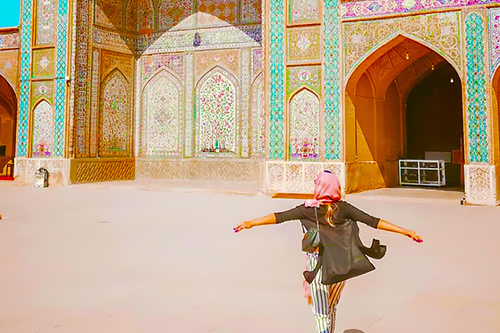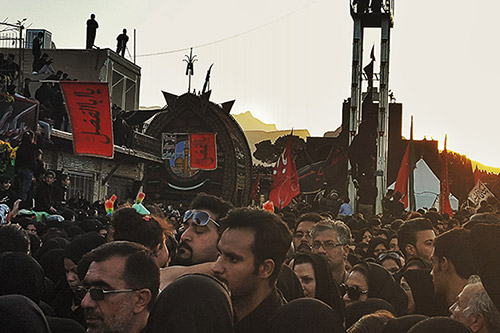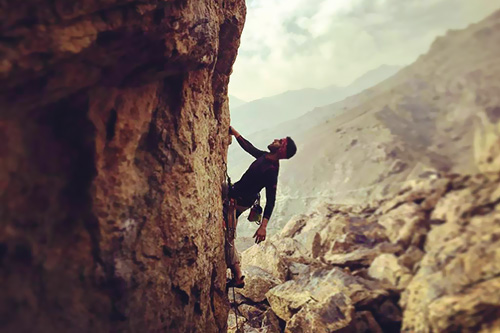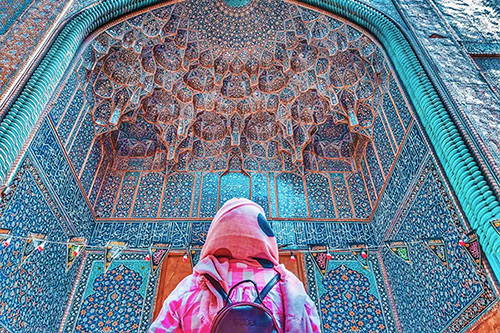 Signin with Google
Signin with Google Signin with Facebook
Signin with Facebook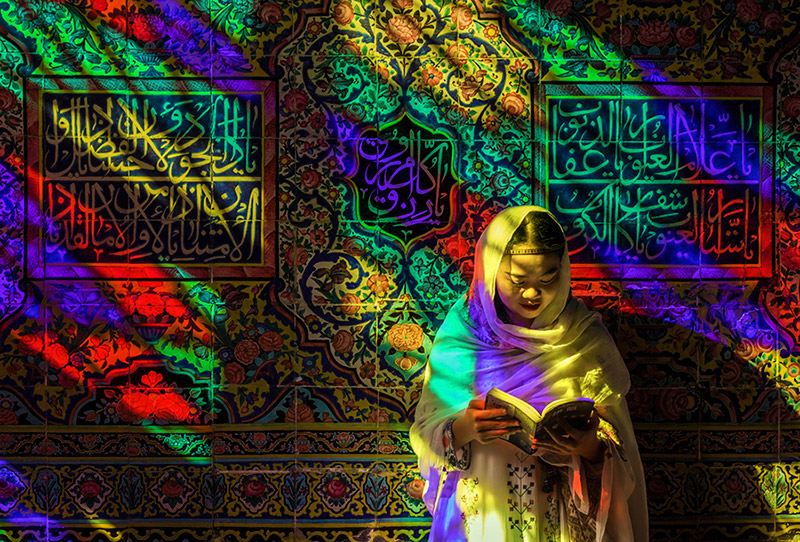 About Iran
About IranTop Things to Do in Shiraz
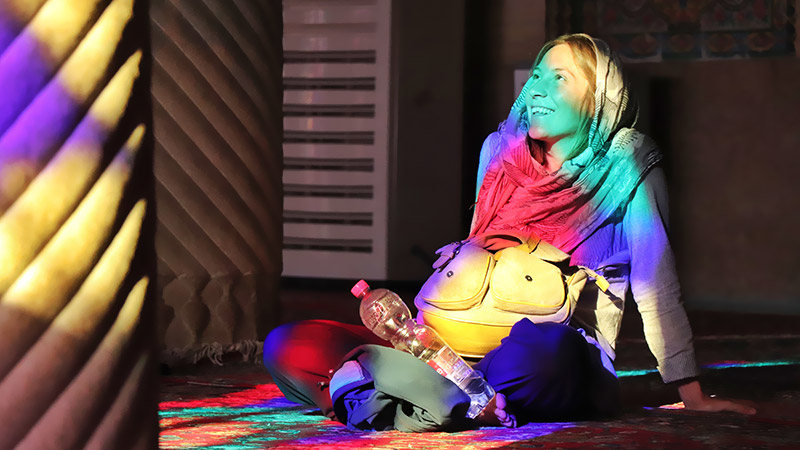
Adjectives are legion to qualify the city of Shiraz, which beauty and culture are peerless. The city of nightingale and roses, the city of wine, the city of poetry, the city of gardens and flowers. All of them refer to the peaceful and pleasant atmosphere of the beautiful capital of Fars Province, which is the original land of Persia and the cradle of the greatest Persian Empires.
Nasir-ol Molk Mosque, the mesmerizing "Pink Mosque"
This is the jewel of Shiraz, a delicate mosque that is truly unique over the world. Its particularity comes from the coloured glass of its windows, which early in the morning, creates extraordinary reflections on the walls and carpets of the prayer hall. It's one of the most elegant mosques in Iran, thanks to its fine coloured tiles and its pink and floral patterns, which are typical of Shiraz. Built at the end of the 19th century under the Qajar dynasty, the pink mosque has kept a truly spiritual atmosphere despite being a highly touristic spot. It is said that this place would lead to meditation and piousness even the most atheist visitor.
Shahcheragh Shrine, lose yourself in contemplation
Several thousands of years ago, where now stands the stunning Shahcheragh Shrine, inhabitants of the city have seen a light coming out of the ground. Soon, believers interpreted it as the sign of the holy presence of the brother of the eighth Shia Imam and the Queen ordered the construction of this mausoleum. Hence the name of this holy site, which means "King of the Light" and which is the most important religious building in Shiraz. The interiors are splendidly decorated with dazzling mirror tiles while the courtyard has delicate blue tiles covering its walls. The rosebud shaped dome, a typical Shirazi feature, is surrounded by two short and shining golden minarets.
Eram Garden, a blend of colours and heavenly scents
Persian Gardens were built in a way to portray paradise on earth, with their geometrical spaces separated by calm waters. The UNESCO-listed Eram Garden as one of the Persian gardens is a bright example of this heavenly perfection. Built under the Qajar, the garden is famous for its fields of roses, its high cypresses and the incomparable scent of its alley of orange trees during spring. Shirazi enjoys walking around its main pool, facing a stunning palace with beautiful tile work, and just walking by the melody of the nightingales.
The Tomb of Hafez, the most beloved Persian Poet
Shiraz is home to the most famous Persian Poet, Hafez, whose poetry is nowadays still known by heart and cherished by every Iranian. Hafez was born and died in Shiraz in the 14th century, and barely left this city that he loved so much. His tomb, located in the centre of a beautiful and delicate garden, is under the protection of a small dome decorated with blue-tiles mosaics. Iranians come here by day and night to read his poetry, meditate and relax. Touching the marble tomb decorated with calligraphies, they whisper their dearest wishes, hoping to have them fulfilled.
The Saadi Tomb and its resplendent garden
As for Hafez, the world-famous Persian Poet Saadi was born and died in the city of Shiraz, at the end of the 13th century. His mausoleum has become a popular pilgrimage site for Iranians and has a peaceful and unique atmosphere, especially at night. Surrounded by flowers and orange trees, the garden holds several small pools as well as an underground pond. This latter is filled with fishes which are for the poet only; a popular belief says that anyone else who would eat them would risk dying. Nowadays, people come to throw a coin in the pond, hoping it will fulfil their wishes and aspirations.
Vakil Bazaar, wandering into a maze of vaulted brick lanes
The Vakil Bazaar, located in the central neighbourhood of Shiraz is probably one of the finest bazaars of Iran. Established in the 11th century, it became the beautiful complex we can now appreciate thanks to Karim Khan Zand, the founder of the Zand Dynasty who ruled over Persia in the 18th century. He commissioned this bazaar to turn Shiraz into a major trading centre, and as a result, it is now one of the best examples of Zand architecture. Over 3000 square meters, it is a maze of vaulted brick lanes, separated by fine courtyards and beautiful caravanserais. Bathhouses have been transformed into cafes and restaurants but have kept their ancestral beauties. Craftspeople and sellers offer traditional Iranian artworks, from copper to carpets, and some of the oldest jobs can still be observed in several of the 200 years old picturesque shops.
Vakil Mosque and the 48 pillars of its night prayer hall
Next to the Vakil Bazaar is the gracious Vakil Mosque, also built under Karim Khan Zand reign, but restored under the Qajar Dynasty. This is recognizable to the beautiful tile work, with typical rose-pink tiles and floral patterns, which decorates the entrance of the mosque as well as the inner courtyard. Besides the impressive two iwans facing each other, the vaulted night prayer hall is the masterpiece of Vakil Mosque: it contains 48 monolithic pillars carved in spirals, with beautifully sculpted domes.
Vakil Hamman, a jewel of Zand arts and architecture
This elegant hammam is part of the Vakil Complex located in the city centre, which reflects the delicate architecture of the Zand Dynasty. Turned into a museum, it depicts how Shirazis used the public baths. It shows that it was not only a place to clean oneself but also a major centre of the social life of the city, where people came to celebrate weddings for instance. What is most impressive in this Hamman is the beautifully sculpted ceilings and vaults of the central chamber as well as the heated room. It is a rare display of fine plasterwork which can't be found in other historic baths in Iran.
Arg of Karim Khan, the Zand's fortress
It's one of Shiraz iconic monuments, dominating the city centre. The Karim Khan citadel is a beautiful bricked rectangular building, surrounded by four 14 meters high circular towers. It somehow looks like a medieval fortress, with its massive entrance crowned by a colourfully tiled fresco. Under the Zand Dynasty, this monument hosted the quarters of the royal family and was used for official ceremonies and receptions. The gracious courtyard is divided by canals and rows of orange trees. For a brief time, it was also used as a prison, before being nowadays a museum.
Narenjestan Garden, immersed by the scent of orange blossom
Smaller than the famous Eram Garden, Naranjestan Garden is nevertheless a true piece of heaven in the city of Shiraz. Full of bitter orange trees, which give the unique scent to the whole city in spring, this lovely garden was built under the Qajar and once possessed by Shiraz's wealthiest families. What makes it so impressive is its main building, the Ghavam Pavillon, decorated with mirrors, tilework, plasterwork, inlay, and painted ceilings. Close-by, the Khan-e Zinat ol Molk pavilion also offers amazements to the eyes and used to be the families' private quarters. Nowadays, it hosts a valuable architectural collection gathered by the American archaeologist Arthur Upham Pope.
The Quran Gate and Khaju Garden
This historical gate is located in the north of the city, and the entrance of Shiraz. On top of it used to be a precious hand-written Quran, that would protect travellers about to leave the city for undertaking a journey, following the Persian tradition. Nowadays, besides admiring the fine architecture of the monument, Shirazis come here to appreciate the delicate atmosphere of the Khaju Garden and its view over the city.
- Around Shiraz -
Living with Qashqai Nomads
Iran has many nomad tribes on its soils, which all have their own identity, culture, and traditions. One of the most famous and largest tribes is the Qashqai, who lives in the southwest of Iran, in Fars Province in particular. Free from the obligations of the modern world, their only master is nature. In order to flee the heat in summer, Qashqai nomads walk with their animals and belongings to cooler places, before returning to warm areas during winter. In recent years, nomads' lifestyle has been affected by modernity, making it harder for them to live from their livestock. Luckily, some of them are still proudly perpetuating their traditional way of life. Being their guest for some days is a unique experience: Sleep in a tent and be their companion, to discover their culture, from food to clothes, language, or music.
Persepolis, the capital of the greatest Persian Empire
The ancient capital of the Achaemenid Empire is one of Iran's main attractions for visitors, who come here to sense the greatness of the Persian Empire. Listed by UNESCO as a world heritage site, it is located 70 kilometres away from Shiraz. Jamshid's Throne, as it is called in Persian, holds 1500 years of history that can be traced into the incredible sculpted bas-reliefs and inscriptions of the site. From the stairs of the great staircase leading to the Gate of All Nations to the columns of the Apadana and the ruins of the Hall of the Hundred Columns, Persepolis continues to recall the greatness of Darius and his successors.
Naqshe Rustam, the Necropolis of Persian kings
Close to Persepolis is the impressive monuments of Naqshe Rostam's necropolis. Four large tombs have been carved high into the rock, protecting inside funeral chambers the remains of Sassanian and Achaemenian kings, among which the famous Darius the Great and Shapur Ist. A massive bas-relief recalls the triumph of this latter over the Roman Emperor Valerian in the Battle of Edessa. Facing the tombs and bas-relief is an enigmatic cubic monument, whose real usage is unclear yet, but might have been a fire temple.
Pasargadae, Cyrus the Great’s ideal city
The tomb of the most glorious Persian king is one of Iran's most famous landmarks. It is located in Pasargadae, some 60 kilometres north of Persepolis. There, in 546 BC, Cyrus the Great started to build a city whose ruins can now be observed. Besides Cyrus' Tomb, a modest cubic burial chamber, are the remains of an audience palace, Cyrus' private quarters, as well as a citadel, on top of the hill. Without forgetting to mention Darius's garden, one of the earliest examples of Persian Garden with its sophisticated irrigation system.
